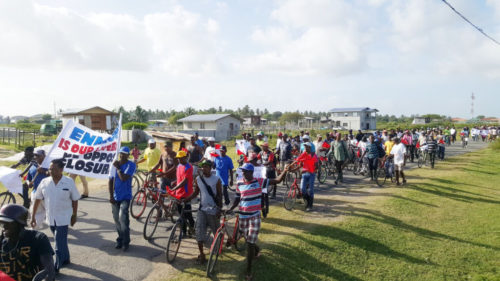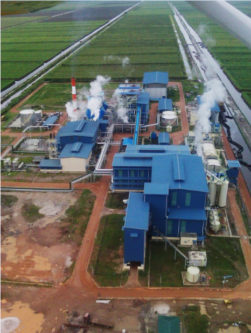This article submitted by the Guyana Sugar Corporation (GUYSUCO) contends that tackling the challenges facing the sugar industry has broader implications for the Guyana economy as a whole.
The process of growth in humans and organizations is similar. In both cases there is a birthing, a maturing and a possible expiration stage. However, organizations can experience a further stage of growth, namely, the stage of rebirthing or renewal. This fact is consistent with the notion that change is constant and while that process is fraught with challenges and difficulties, resistance to change can prove fatal.
As the Guyana Sugar Corporation Inc. (GuySuCo) is examined and possible scenarios and options for its future reviewed with a view to arriving at the best economic, social and other appropriate solutions to its current challenges, it is an opportune time to consider the stages of growth for the Corporation and what the New GuySuCo will look like.
The Past
– Birthing of Sugar in Guyana
Sugar has been a major part of Guyana’s history since the 17th century when estates emerged in the Essequibo region. By the 18th century plantations were extended to Demerara and Berbice. By the early 19th century there were about 400 sugar plantations and by 1928, there were 62 sugar factories in Guyana.

Over the centuries there has been a progressive rationalization of the industry.
During the period of 1975 to 1976 when the industry was nationalized, there were 11 estates, located at Leonora, Uitvlugt, Wales, Diamond, Enmore, La Bonne Intention, Ogle, Albion, Blairmont, Rose Hall and Skeldon.
Due to the sheer size of the industry it was always positioned at the centre of the country’s economy as well as its socio-political experience. Accordingly, GUYSUCO has remained vulnerable to both external and internal considerations.
The reform of the European Union (EU) Sugar Protocol under which the African Caribbean and Pacific (ACP) states had been exporting sugar to the EU between 1975 and 30th Septem-ber 2009, was a significant external shift which compounded what had already been a growing instability in the country’s sugar industry. In effect, these reforms resulted in a 36 percent drop in the market price for sugar which translated into a G$ 7 billion annual reduction in revenue from the industry.
Internal challenges did little to alleviate the situation. These included loss of skills, increased production costs, an adversarial industrial relations climate and unpredictable and often unfavorable weather patterns.

More recently, GUYSUCO has been affected by the outcome of the Skeldon Sugar Modernisation Project, envisaged as a flagship project for the industry and intended to deliver a modern factory, expanded cane cultivation, a refinery and a co-generation facility for electricity for the national grid. Poor workmanship, poor commissioning, heavy rains and a scarcity of skills and experience proved to be major obstacles to the success of the project.
A substantial portion of the US $200M that was invested in the development of the Skeldon Project (both factory and agriculture) came from GUYSUCO’s reserves. The remaining amounts were acquired through loans so that the shortcomings of the project was a blow from which the industry never really recovered.
The Present
– Maturing of the Sugar Industry
The EU Sugar Protocol reforms, loss of skills and experience, the poor outcome of the Skeldon investment, high production costs, a sustained adversarial industrial relations climate and erratic weather patterns have collectively contributed to the current condition of the sugar industry. This has nonetheless, created the space for a ‘new normal’ for the sugar industry.
Sustainable business thinking allows for an enterprise to undertake continuous critical reviews of its operations in order to remain relevant and competitive. The position in which GUYSUCO finds itself underscores the need for timely review and reorganizing.
GUYSUCO has missed opportunities to reorganize itself in order to remain competitive and relevant. I neglected, for example, to apply funds from the European Union’s Accompanying Measures Programme to the reorganization of the industry, as was done in Mauritius and Fiji. Thus in 2017, the Corporation finds itself at a crossroads. Whatever option is embraced, going forward, the chosen option must embrace a mind – set that is bold and radical in the decision-making process.
The Future
– Renewal of the Sugar Industry
With 17,000 employees and a Corporation which impacts both directly or indirectly on the approximately 80,000 persons (almost 9 percent of the population or 16 percent which represents both employees and their families as well as business and support services who directly and indirectly benefit from the existence of the industry) no component of the decision- making process or the rolling out of the re-organization strategy will be easy. What is reassuring, however, is that the current circumstances of the industry have created new and numerous opportunities. The White Paper recently presented to the Parliament by the Minister of Agriculture envisages a new GuySuCo that will include an amalgamation of estates – Albion-Rose Hall, Blairmont and Uitvlugt-Wales estates which, together, will have an annual production target of 147,000 tonnes of sugar. The industry will also have a diversification component. The new GUYSUCO also envisages that the Albion and Rose Hall estates’ cultivation will be amalgamated and that the Rose Hall and Enmore factories will be closed at the end of 2017. Further, portions of lands from both the Rose Hall and East Demerara Estate will be made available for diversification purposes.
On the issue of employment GUYSUCO will retain as many of the 17,000 employees to work both in sugar and diversification. Interested employees will also have the option of securing leased lands to engage in farming to support the agro-based entity which the Corporation will become.
An opportunity has also been created for the GUYSUCO to maximize its strengths in order to capitalize on the opportunities available to recover cost for services for which it did not receive before. Two of the many strengths which the Corporation has and which can be used in its cost-recovery pursuit are:
(1) GUYSUCO’s ability to manage and maintain drainage and irrigation facilities AND
(2) GUYSUCO’s ability to provide a high level of primary health care services through its fifteen (15) Primary Health Care Centres and two (2) Diagnostic Centres.
Based on financial and technical analyses of the Corporation it has been determined that the amalgamation of estates is, in some instances, feasible. Additionally, prudent management and much smaller yet adequate capital injection by government into the three remaining estates can result in GUYSUCO becoming a profitable entity in three (3) years. In effect the current annual bailouts will no longer be necessary. Some of these funds can be used to create more sustainable and resilient communities particularly in areas that are predominantly sugar-dependent at this time.
What has long been apparent is that sugar dependent – communities are uniquely vulnerable to the pressures and shocks that occur in the sugar industry. The creation of more sustainable and resilient communities will render them both better off and more dynamic. In a broader sense, the aim of this initiative will be to engage sugar-dependent communities in a process that allows for a determination of what their preferred growth areas are and and an effective examination of the state of fiscal and economic health of these communities. Additionally, it will help in realizing an effective audit of the skills and expertise within these communities. Further, it will help to determine the economic opportunities that are already available in these communities and how those opportunities can be optimally exploited. Finally, the focus of the initiative will be on fashioning development strategies for the use of estate lands from the Wales, Rose Hall and East Demerara estates.
GUYSUCO’s current challenges present a rare opportunity for a single industry to be the catalyst for positively changing the shape of the Guyana economy. (Currently the economy has a triangular shape with a small group at the top, a slightly larger group at the middle, and a huge group at the bottom) The GUYSUCO challenge presents an opportunity to grow that group in the middle by putting more ownership and responsibility into the hands of the group at the bottom thus making them masters of their own destiny and ultimately changing the shape of the economy.





